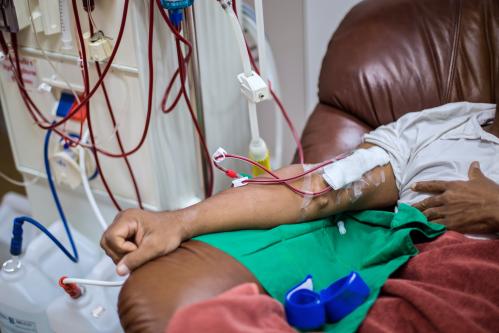The U.S. Food and Drug Administration (FDA) plays a critical role in ensuring that medical products entering the market are safe and effective for their intended use. FDA’s statutory authority, however, does not extend to how products are used in clinical practice, which falls within the scope of the practice of medicine. As a result, once prescription drugs are approved for marketing, they can be (and often are) used “off-label” by prescribers to treat conditions and/or patient populations that were not studied in clinical trials. When supported by ongoing evidence development on product safety and effectiveness in the postmarket setting, off-label use can result in highly effective treatment for many conditions. However, such use may also introduce unnecessary risks for those patients for which evidence of benefits and risks have not been evaluated scientifically.
A central component of FDA’s drug approval process includes weighing the balance of the benefits and risks of a product in all patients likely to receive treatment with the drug. If the likelihood of off-label use is high for a drug intended to treat a limited subpopulation, FDA may require data from clinical trials on the broader population, since the benefit-risk balance may be very different in a broader population of patients. For example, patients with life-threatening morbid obesity may be much more willing to accept a higher likelihood of serious adverse reactions for a substantial level of weight loss potential with a new drug than patients who are moderately overweight. Furthermore, if the weight loss potential is greater in the more extreme patients, the clinical use of the new drug may only be appropriate and acceptable in those patients since using the drug in the moderately overweight patients may expose them to unnecessary risk without much benefit.
For drugs with a narrow indication of seriously ill high-risk patients, requiring more data to evaluate benefits and risks in the broader patient population comes at a cost. The most recent comprehensive study of drug development costs estimated the average cost of drug development of a new drug at $1.5 billion U.S. dollars, with an average development time of 11.5 years before market entry.[1] The inclusion of a large and more heterogeneous population of patients requires more complex clinical trials than a narrow, targeted trial. Larger trials also take longer to enroll patients and to collect the relevant clinical outcomes, and as a result are more costly. A major concern is that these factors significantly delay access to narrow indication treatments for high-risk subpopulations for which there may be few or no alternative therapies, or may ultimately prevent a product with a small market from ever being developed. While there are a number of regulatory pathways intended to expedite the availability of innovative new drugs to treat serious conditions (e.g., Fast Track, accelerated approval, breakthrough therapy designation), there persists a degree of uncertainty about how products targeted toward a narrow group of high-risk patients with a prevalent condition will be evaluated by FDA. This lack of clarity has impacted investors’ and drug developers’ willingness to develop products aimed at the highest-risk populations. This is not a problem for orphan drugs, which are developed specifically to treat very rare diseases (i.e., orphan diseases) and have extended periods of market exclusivity if approved because orphan diseases are already population-limiting and off-label use is typically not a concern.
Recently, a number of mechanisms have been proposed to support the development and approval of products for the most high-risk patient subpopulations with unmet medical needs. The common goal of these proposals is to provide a clear and more targeted pathway that could accelerate innovation by making development of these products more attractive. Several proposals, including the Infectious Diseases Society of America’s Limited Population Antibacterial Drug proposal, include the caveat that the use of these products will need to be limited to the patient subpopulations for which they are indicated if limited clinical trial data are submitted for approval. In September 2012, the President’s Council of Advisors on Science and Technology (PCAST) issued its report, Propelling Innovation in Drug Discovery, Development, and Evaluation, which included a recommendation to create a “Special Medical Use” (SMU) pathway. The SMU pathway would allow FDA to approve a drug with a narrow indication for a subpopulation of patients with unmet medical needs. This could include patients that have a more severe form of a condition, are at particularly high risk from a condition, or who have a specific disease subtype. According to the PCAST recommendation, the SMU designation would be voluntary and initiated by drug manufacturers early in drug development for products targeting areas of unmet medical need. The manufacturer would also need to demonstrate that clinical trials in a larger population of patients would require much longer time periods to complete or would not be feasible.
While the new pathway would allow manufacturers to study only the narrow patient subpopulation for approval, it would not change the traditional evidentiary requirements set forth by the 1962 U.S. Kefauver Harris Amendment to the Federal Food, Drug, and Cosmetic Act. Manufacturers would still be required to conduct adequate and well-controlled studies to produce substantial evidence of safety and effectiveness. In addition, once the SMU product was approved by FDA for marketing, special labeling and a logo would identify the product as an SMU-designated product to alert the health care community and patients that safety and efficacy have only been demonstrated in the indicated subpopulations.
Some feel that a new pathway is not needed because FDA already has the legislative authority to approve products for narrow indications and require specific labeling. While this may be true, a new designation would be helpful in providing a clearer path for product development, approval, and appropriate use. Examples of therapeutic areas in which the SMU pathway could be an important mechanism for addressing unmet medical needs include severe, multi-drug resistant infections, and patients at the high-risk end of a disease spectrum, such as those with morbid obesity. Conditions where disease severity and progression are more difficult to characterize, such as Parkinson’s disease and Alzheimer’s disease, may pose more challenges in delineating patient subgroups and supporting appropriate on-label use.
The SMU pathway would be a promising new tool and should move forward. The most important benefit would be the potential for more therapeutic options and faster access to innovations for seriously ill and high-risk subpopulations of patients. For drug manufacturers and venture capitalist firms, it could provide a clearer development pathway to encourage investment in development programs that include smaller, more rapid, and more efficient clinical trials tailored to smaller and more homogeneous populations. However, the only way the only way this type of regulatory pathway would be effective is if providers, payers, manufacturers, and patients do their part in supporting appropriate use of these products. For example,
- physician practices and hospitals can ensure that local practice guidelines specify the indicated patient subpopulation;
- payers and pharmacy benefit managers can require the prescribing physician to submit clinical justification in order to receive reimbursement (i.e., prior-authorization); and
- community pharmacists, by engaging in dialogue with the patient (and prescriber, if necessary), could ensure that the product is being used appropriately and according to the drug’s indication.
It will be important to make sure there is also a complementary path for manufacturers to continue studying the product in broader populations with the disease. With additional clinical study, products might also be shown to have a positive benefit-risk balance for patients with moderate or milder manifestations of more prevalent conditions. The SMU designation and pathway should not unintentionally impede additional clinical research or patient access to broader patient groups that would be achieved under the traditional approval pathways.
On August 1, 2013, the Health Care Innovation and Value Initiative within the Engelberg Center for Health Care Reform at Brookings held an expert workshop, “Special Medical Use: Limited Use for Drugs Developed in an Expedited Manner to Meet an Unmet Medical Need.” A range of expert stakeholders engaged in a day of discussion and debate on a variety of issues related to the design and implementation of the proposed pathway. For more information on these issues, please visit the event page.
[1] “The R&D Cost of a New Medicine.” Office of Health Economics. December 2012. Accessed online at: http://www.ohe.org/publications/article/the-rd-cost-of-a-new-medicine-124.cfm
The Brookings Institution is committed to quality, independence, and impact.
We are supported by a diverse array of funders. In line with our values and policies, each Brookings publication represents the sole views of its author(s).



Commentary
Unmet Patient Needs as the Focus of a New Regulatory Pathway
August 13, 2013